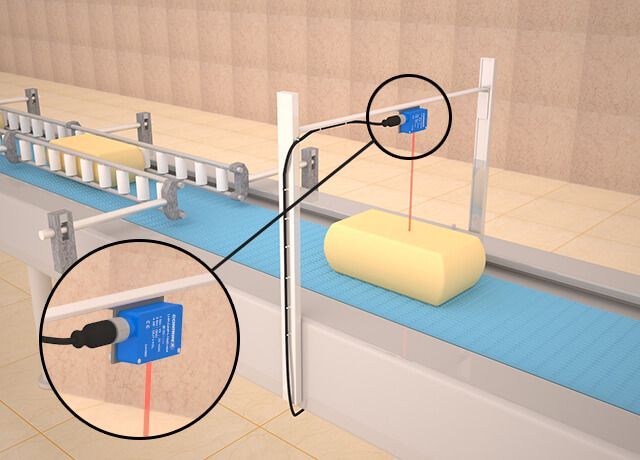Summary
During high-volume production of individually packaged cheese portions, conveyors deliver product to packaging stations. In-line buffering stations regulate flow to match packaging throughput; miniature Ecolab-certified sensors detect the presence of each portion after buffering, triggering the packaging cycle. Sensitivity parameters for each portion size, stored on the sensor’s inbuilt memory, may be updated remotely without manual intervention, eliminating the need for unplanned sanitization between batches.
Customer Values
- Ecolab-certified sensors are ideal for hygienic production facilities
- Wide operating range accommodates full range of portion sizes
- Sensitivity parameters are retrieved or updated remotely via IO-Link
- Unnecessary sanitization between batches is avoided
- Simple one- or two-step teach procedure optimizes initial sensor set-up
- Stability alarm highlights reduced sensitivity, avoiding unplanned stoppages
- Downtime is avoided by eliminating the need for technicians to attend machines
Specific Product Advantages
- Ecolab-certified photoelectric sensors with background-suppression mode
- IO-Link serial-connection protocol enabled on PNP versions at no additional cost
- Pre-taught sensitivity parameters stored on inbuilt sensor memory
- Remote sensitivity retrieval or update via IO-Link
- Robust sensors with miniature (20mm x 30mm x 10mm) plastic housings
Customer Application
A Swiss manufacturer of premium dairy products produces a range of individually packaged cheese portions in a high-volume hygienic production facility. Once cut to size, cheese portions travel on a food-grade conveyor to a packaging station; the duration of the packaging cycle is dependent on the type of cheese and the portion size.
Prior to packaging, a buffering station produces a regular flow of portions with a predetermined spacing to suit the packaging throughput. The two operations must be synchronized; the manufacturer requires a sensor system that detects the presence of each cheese portion as it leaves the buffering station, triggering the packaging cycle.
Sensors must be food-grade certified and withstand the aggressive cleaning agents used during washdown routines. They must also accommodate the full range of portion sizes without the need for manual adjustment, as this would necessitate sanitization each time the portion size changes. Maximizing throughput is an additional priority; rapid changeover between product batches is essential.
Customer Solution
Ecolab-certified, diffuse-mode photoelectric sensors with background suppression from the Contrinex C23 product family are ideally suited to this application. These miniature cubic devices, mounted above product conveyors immediately after each buffering station, detect the presence of cheese portions as they pass underneath. Positioning sensors is simple thanks to a range of adjustable stainless steel mounting brackets.
An industry-standard PNP normally open output with an M8 connector ensures optimum flexibility. Additionally, IO-Link, a standardized point-to-point serial connection protocol for sensors and actuators, is enabled on PNP versions at no additional cost, offering the advantages of digital communication without the need for special cabling. A second output provides a stability alarm in the event of reduced sensitivity, flagging the need for preventative maintenance before any performance degradation occurs.
Robust sensor construction, featuring miniature (20mm x 30mm x 10mm) plastic housings, ensures reliable operation in the demanding washdown environment; Contrinex C23 devices are rated to IP67. An operating range between 15mm and 250mm, adjustable via a teach button or via IO-Link, accommodates the range of portion sizes without compromise.
A brief one- or two-step teach procedure simplifies initial set-up. One-button operation allows process engineers to teach the target object and, optionally, the background, each time a new portion size is introduced. Once taught, sensitivity parameters are stored on the sensor’s inbuilt memory and may be retrieved or updated remotely via IO-Link, eliminating the need for manual adjustment.
These rugged miniature sensors meet the customer’s need for reliable operation with little or no manual intervention, while unplanned sanitization is avoided. The solution is highly cost-effective with minimal non-productive time; throughput is maintained at or above target levels.
